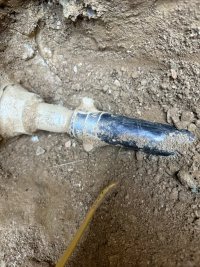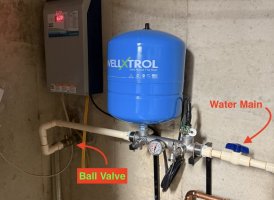oneskinnydave
New Member
I had a new constant pressure well system put in almost 2 years ago at this point - no issues really but had the system kick off the other day with an overvoltage error so I restarted it and everything was fine. I did notice the pressure was dropping ~5-6psi every 30-40 seconds or so, then kicking back on - we noticed our electric bills creeping up the last few months, so I’m guessing it’s been going on for a little while now. I was able to shut the main off inside and still get a pressure drop so I know it’s somewhere outside.
I had the plumber that installed the system come out - they thought it might be the check valve, which I think they replaced at the pump, and inspected the pitless adapter, and replaced the o-ring inside - at that time not much had changed. They suggested next step to inspect the outside seal of the adapter and throw a check valve inside the house (though that wouldn’t fix the problem obviously!).
I’ve dug down to the adapter this weekend (sheesh that was a workout!) - and I don’t see any excessive leaking - let it sit overnight and no pooling or anything out of the ordinary, just some sore muscles.
I decided to shut the water down late last night at the main in the house to see how much cycling was going on (I was working in the storage area next to it) - and it….was holding pressure…which was made me question everything! Did some testing now the family is out of the house - so far it's been 45 minutes and only dropped 1psi at the inside unit.
I'm going to send a better camera down into the casing to see if I see any tell tale signs of water - I sent down a cheap inspection camera which was hard to tell, but might get a gopro and flashlight down there on a pole to get a better shot of it all - but is there anything else I'm overlooking here? I might shut the pump off overnight and see how much pressure I lose while closing the main valve too, it just gets tricky in a household of 6 right now!
I had the plumber that installed the system come out - they thought it might be the check valve, which I think they replaced at the pump, and inspected the pitless adapter, and replaced the o-ring inside - at that time not much had changed. They suggested next step to inspect the outside seal of the adapter and throw a check valve inside the house (though that wouldn’t fix the problem obviously!).
I’ve dug down to the adapter this weekend (sheesh that was a workout!) - and I don’t see any excessive leaking - let it sit overnight and no pooling or anything out of the ordinary, just some sore muscles.
I decided to shut the water down late last night at the main in the house to see how much cycling was going on (I was working in the storage area next to it) - and it….was holding pressure…which was made me question everything! Did some testing now the family is out of the house - so far it's been 45 minutes and only dropped 1psi at the inside unit.
I'm going to send a better camera down into the casing to see if I see any tell tale signs of water - I sent down a cheap inspection camera which was hard to tell, but might get a gopro and flashlight down there on a pole to get a better shot of it all - but is there anything else I'm overlooking here? I might shut the pump off overnight and see how much pressure I lose while closing the main valve too, it just gets tricky in a household of 6 right now!





